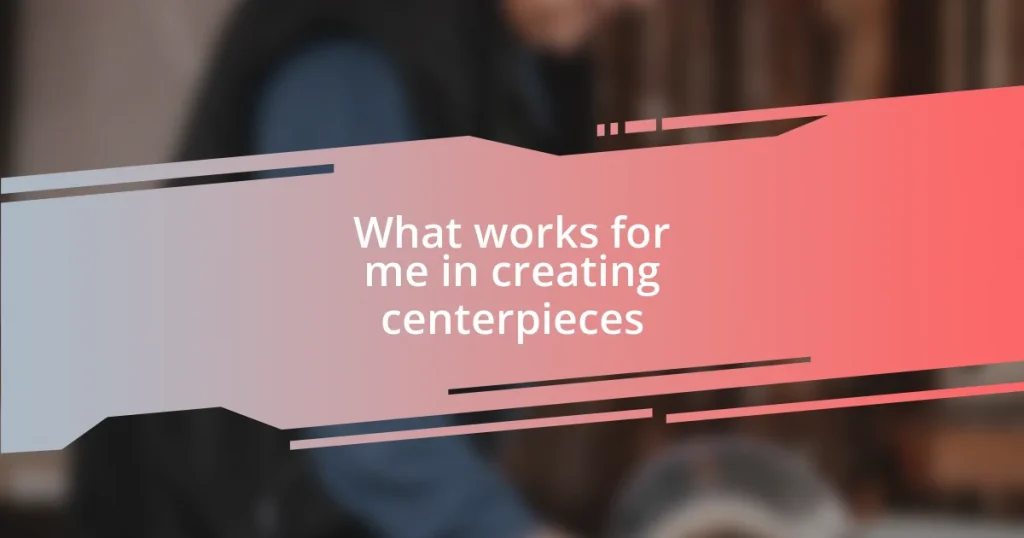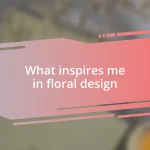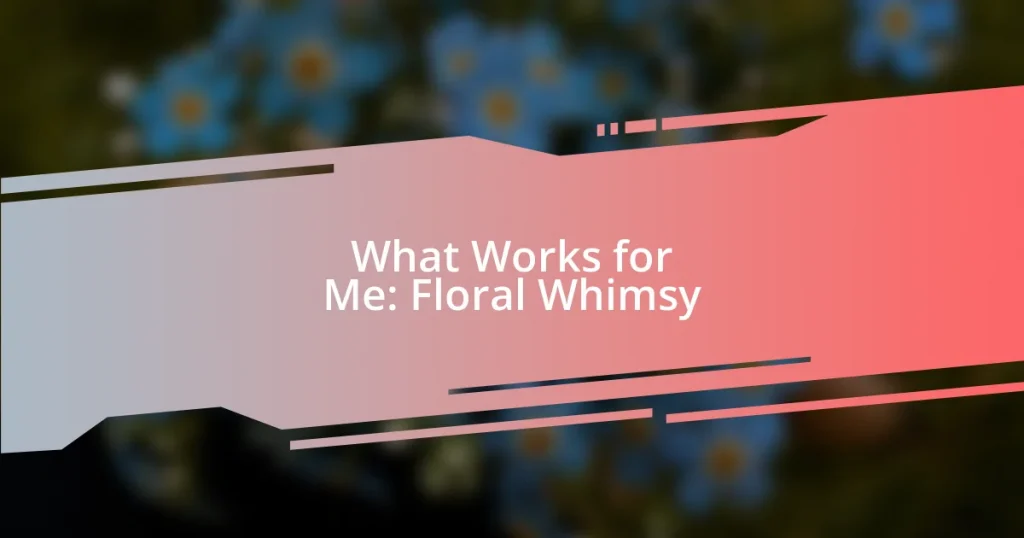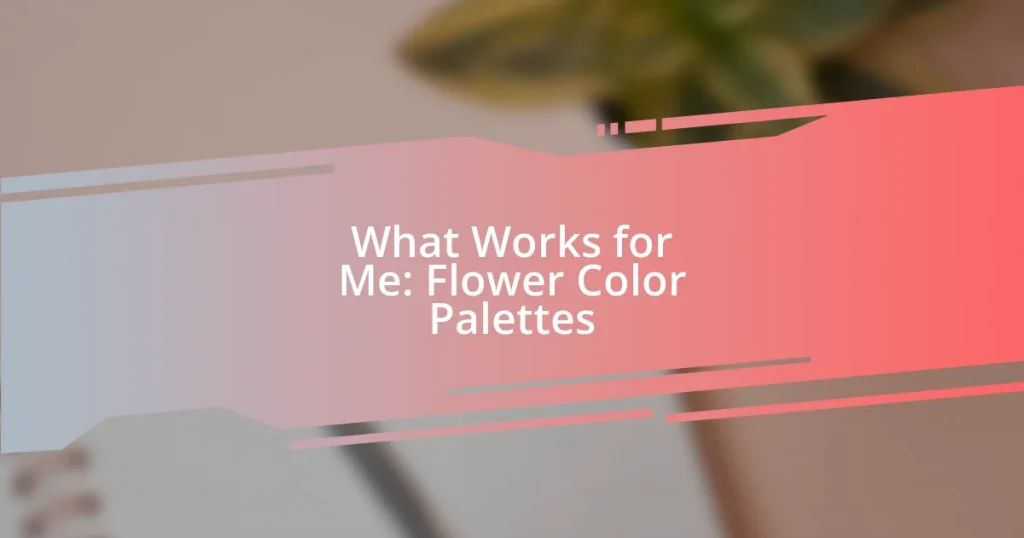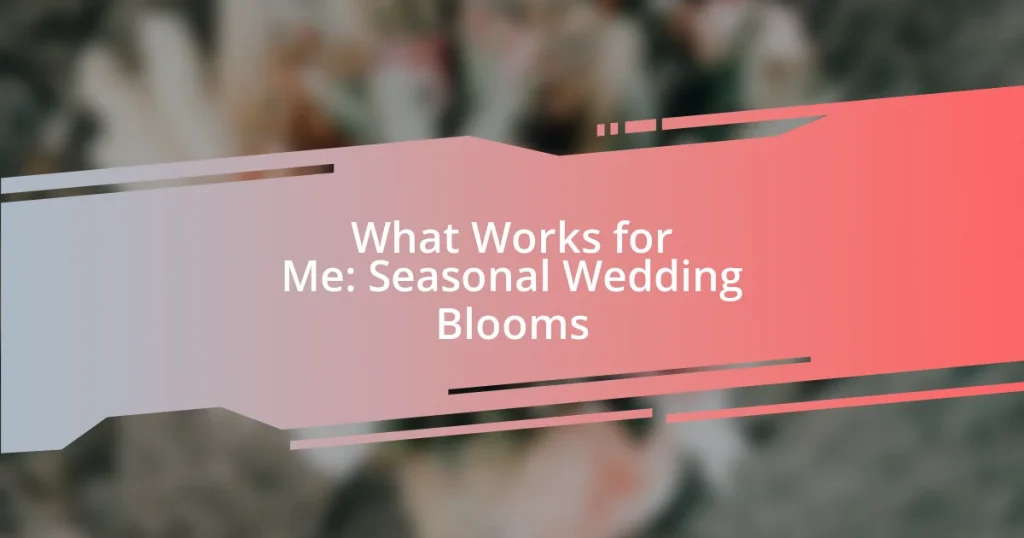Key takeaways:
- Choose centerpiece styles based on the desired mood and theme, considering height and scale for guest interaction.
- Utilize color harmony techniques, such as monochromatic or complementary color schemes, to evoke specific emotions and enhance ambiance.
- Add personal touches and meaningful items to centerpieces for emotional connection, while ensuring stability through careful material selection and arrangement techniques.
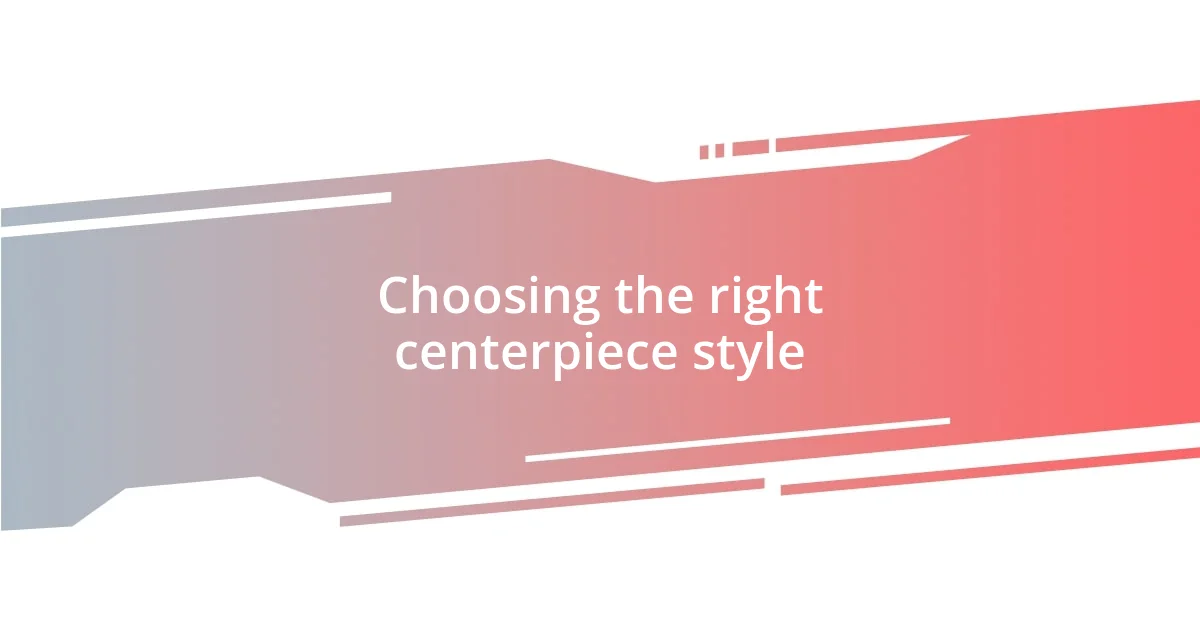
Choosing the right centerpiece style
When it comes to choosing the right centerpiece style, I always start by considering the mood I want to create. Do I want something playful and vibrant, or perhaps more serene and understated? I once attended a wedding where the centerpieces were simple white flowers in mason jars. They created such an inviting atmosphere that I couldn’t help but feel relaxed and at ease.
Every detail counts, so think about the theme of your event. I remember planning a cozy autumn gathering and opted for rustic wooden boxes filled with seasonal blooms and small pumpkins. It instantly connected everyone with the season, sparking conversations about our favorite fall memories. What effect do you want your centerpiece to have on your guests?
Additionally, height and scale are crucial factors. I learned this when I mistakenly used tall, elaborate centerpieces at an intimate dinner party. They blocked our view of each other, making conversations awkward. Instead, I now favor versatile pieces that allow guests to interact and enjoy their meal. How might you find that perfect balance for your gatherings?
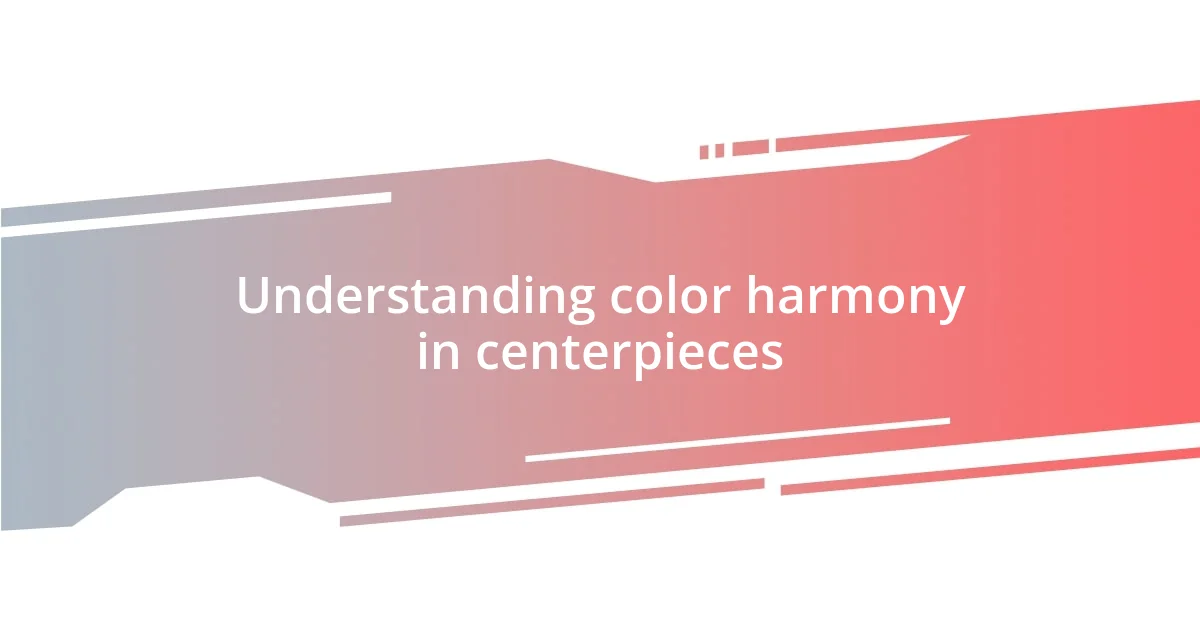
Understanding color harmony in centerpieces
Understanding color harmony in centerpieces involves recognizing how different colors interact and the emotional responses they evoke. For instance, I once used a monochromatic scheme of varying shades of blue in a centerpiece for a summer soirée. The effect was soothing and calming, making guests feel relaxed as they mingled. Keeping colors in the same family can promote a sense of unity.
I’ve also experimented with complementary colors, which are those opposite each other on the color wheel. For a birthday celebration, I paired vibrant orange blooms with deep blue accents, creating a lively atmosphere that sparked joy and conversation. This dynamic combination energized the space. When selecting hues, consider the emotions you want to evoke and how they will enhance the overall experience.
Exploring color temperature is another critical aspect of color harmony. Warm colors like reds and yellows can make a space feel lively and festive, while cool colors like greens and purples often promote tranquility. At a garden party I hosted, I opted for soft lavender and pale green elements, which beautifully reflected the lush surroundings, creating a serene setting. What colors resonate with you, and how can they influence the ambiance of your event?
| Color Harmony Type | Description |
|---|---|
| Monochromatic | Uses variations of a single color for a harmonious look. |
| Complementary | Combines colors from opposite sides of the color wheel for contrast and vibrancy. |
| Analogous | Employs colors adjacent to each other on the color wheel for a harmonious blend. |
| Triadic | Incorporates three colors evenly spaced on the color wheel for a balanced, vibrant scheme. |

Selecting your centerpiece materials
Selecting materials for your centerpiece is where the magic begins. I find that the texture and quality of the materials can transform an ordinary arrangement into something truly captivating. For instance, at a recent dinner party, I used a mix of crystal and wood, which created a beautiful contrast that caught my guests’ attention. They couldn’t help but comment on how the sparkling glass reflected the flicker of candlelight while the rustic wood tied everything to a cozy, inviting atmosphere.
Here’s a list of materials I love to work with when crafting centerpieces:
- Flowers: Fresh blooms add color and life, while dried flowers can evoke nostalgia and warmth.
- Candles: Varied heights create depth, and they cast a lovely glow that enhances the mood.
- Textiles: Linens, lace, or burlap can add softness and richness; consider their impact on the overall aesthetic.
- Containers: Jars, vases, or baskets can change the theme; think about reusing items creatively!
- Natural Elements: Rocks, twigs, or shells can bring in earthy textures that connect your centerpiece to nature.
I’ve also discovered that seasonal elements enhance the connection to the current time of year. For a spring brunch, I incorporated delicate blossoms, fresh herbs, and pastel-colored linens. The cheerful vibe it created made everyone feel rejuvenated, almost as if we were all celebrating the beginning of new beginnings. It was such a joy to witness guests savoring the moment, reminiscing about our last spring gathering, and looking forward to the sunshine ahead. How might you bring seasonal flair into your arrangements?

Incorporating seasonal elements effectively
Incorporating seasonal elements can truly elevate a centerpiece. I remember hosting a cozy autumn dinner where I filled my centerpiece with vibrant orange and deep red leaves, along with small pumpkins nestled among standard white candles. The warm colors evoked the essence of fall, not just setting a mood but also sparking conversations about harvest traditions and Thanksgiving plans. Isn’t it remarkable how colors can weave memories and connections in such a simple setting?
For winter gatherings, I love bringing in evergreens and pine cones. One year, I created a centerpiece featuring a mixture of white flowers with frosted pine branches, which really reminded everyone of the holiday spirit. The added touch of a few sparkly ornaments brought a sense of whimsy and excitement. What seasonal elements resonate with you? Those touches can be a sweet reminder of moments shared during a specific time of year.
When I think about summer, I gravitate towards the vibrant palette of fresh fruits along with colorful floral arrangements. At a picnic-themed event, I adorned the table with sliced citrus fruits as part of the centerpiece, surrounded by sunflowers. It not only looked stunning but also smelled delightful, embodying the carefree essence of summer. How can seasonal elements transform your centerpiece into a conversation starter and a memory maker?
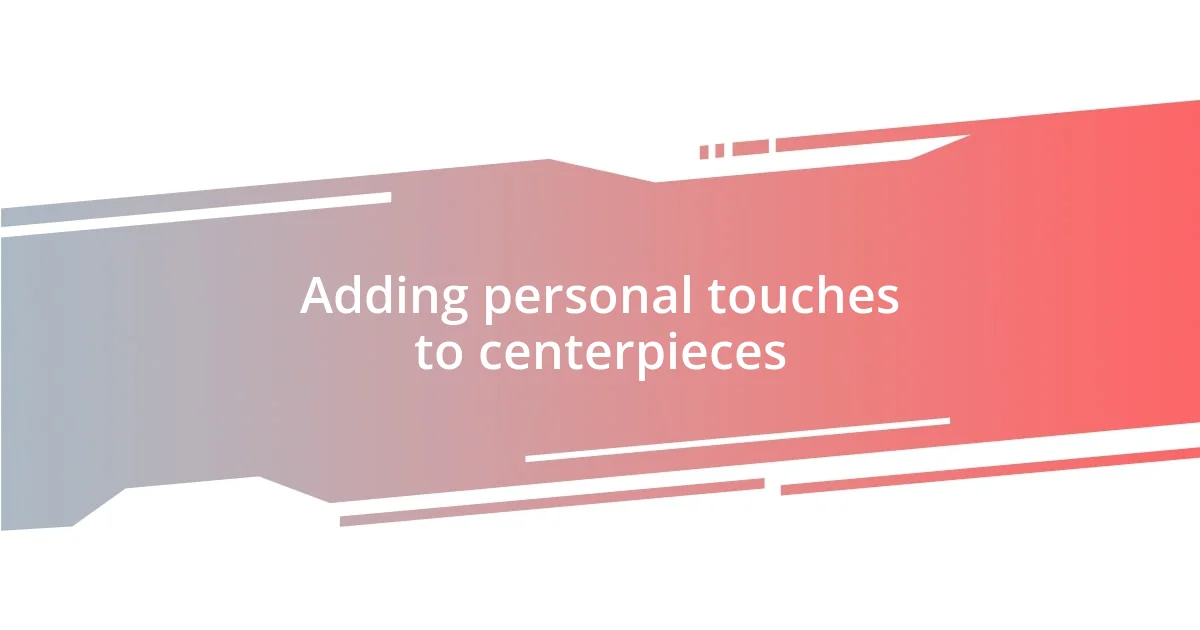
Adding personal touches to centerpieces
I believe adding personal touches to centerpieces is where true creativity shines. For my sister’s wedding, I used small framed photos of family members at each table. It not only sparked conversations but also made guests feel connected to the couple’s journey. Isn’t it wonderful how a simple photograph can evoke cherished memories and stories?
Embellishing with meaningful items can heighten the emotional aspect of your arrangement. During a birthday celebration, I placed a few childhood toys of the birthday boy within the centerpiece. Each item told a story that made the atmosphere richer and added laughter. Have you thought about incorporating items that are significant to the occasion or the people involved?
Lastly, I love to incorporate handwritten notes or quotes from the host or honoree within my centerpieces. At a recent gathering, I folded little notes with favorite quotes around the base of a floral arrangement. Guests appreciated the thoughtful touches, and it gave them something to ponder while enjoying the evening. What unique messages or memories could you weave into your centerpieces to make them truly your own?

Arrangement techniques for visual impact
When creating visually impactful centerpieces, my go-to technique is to play with height and layers. For a birthday brunch I hosted last spring, I placed a tall, slender vase filled with lilies at the center, surrounded by shorter, wider arrangements of daisies and greenery. This variety not only drew the eye upward but also established depth, making the overall arrangement feel more dynamic. Have you noticed how different heights can add drama and keep guests intrigued?
Color contrasts are another effective strategy to enhance visual appeal. During a recent family reunion, I combined deep blue hydrangeas with bright yellow sunflowers, creating a striking focal point on our long dining table. The unexpected pairing caught everyone’s attention and sparked compliments, which led to lovely discussions about our favorite flowers. How might experimenting with contrasting colors transform your centerpiece into a stunning visual story?
I also find that symmetry can create a sense of harmony and balance in arrangements. For one wedding, I arranged identical pairs of candle holders on either side of a central floral display. This layout not only created a cohesive look but also provided a soothing aesthetic that complemented the couple’s elegant theme. What kind of balance can you achieve in your arrangements to create that perfect visual impact?
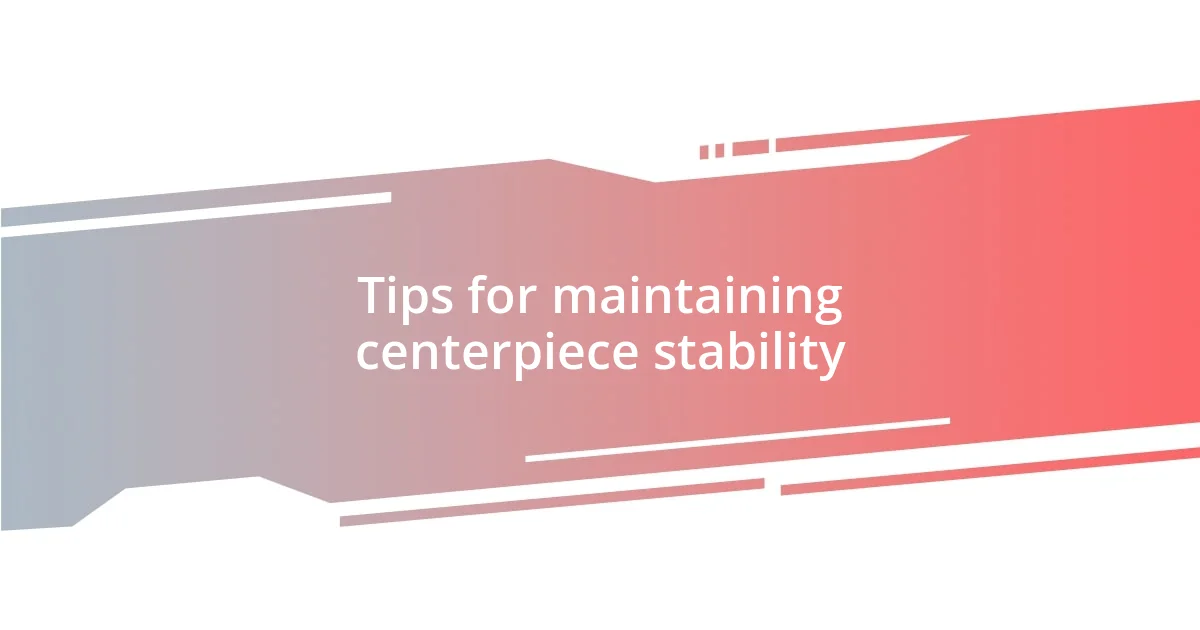
Tips for maintaining centerpiece stability
To ensure stability in your centerpieces, it’s key to consider the weight distribution of your elements. I often incorporate heavier items, like candles or stones, at the base of my arrangements. During my last dinner party, using a sturdy glass container filled with pebbles not only anchored the floral arrangement but also created visual interest. Have you thought about what materials can provide both balance and beauty in your designs?
Another tip that has proven effective for me is using floral foam or stone, especially when working with delicate flowers. In one springtime gathering, I placed my flowers into a block of floral foam soaked in water. This not only secured their placement but also kept them hydrated throughout the event. It’s fascinating how a small step like that can prolong the freshness of your centerpiece—what tricks have you found to maintain the vibrancy of your arrangements?
Lastly, I’ve learned that the choice of the right container can greatly enhance stability. For instance, when I hosted a cozy autumn gathering, I filled a wide, low bowl with seasonal fruits surrounded by smaller decorative pumpkins. This low-profile design prevented tipping while also adding a rustic charm. Have you considered how varying container shapes can impact the overall security of your pieces?










